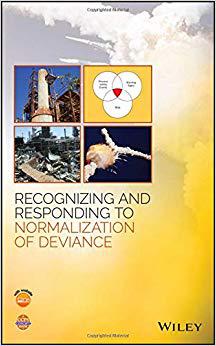图书简介
An essential guide for recognizing and responding to normalization of deviance to help organizations improve their process safety performance This book provides an introduction and offers approaches for finding and addressing normalization of deviation both in operational and organizational activities. It addresses the initial and long-term effects of normalization of deviations as seen in reduced efficiencies, reduced product quality, extended batch run time, and near miss process safety incidents which can lead to loss of containment of hazardous materials and energies. Recognizing and Responding to Normalization of Deviance addresses how to recognize and respond to the normalization of deviation that can, and almost certainly will, occur in any ongoing operations that involves humans. The book?s primary focus is on reducing the incidence of normalization of deviation and the associated increased risk exposure due to its effects when operating chemical or petrochemical manufacturing facilities. It contains an introduction to the concept and offers approaches for finding and addressing normalization of deviation when it presents itself in both operational and organizational activities. Contains guidance to assist facilities in recognizing and addressing the phenomenon of normalization of deviation Provides techniques for addressing normalized deviations and techniques to eliminate waste in all manufacturing processes Describes methods for identifying normalized deviation as well as where to find deviations Includes techniques to reduce operational normalization of deviance and to reduce organizational normalization of deviance Aimed at process safety professionals and consultants applying process safety risk reduction efforts in manufacturing areas, Recognizing and Responding to Normalization of Deviance is an important book for any organization that has seen its process safety performance deteriorate over time.
List of Tables xi List of Figures xiii Glossary xv Acronyms and Abbreviations xxi Files on the Web xiii Acknowledgements xxv Preface xxvii Executive Summary xxix 1. Introduction 1 1.1 The Definition of Normalization of Deviance 5 1.2 The Motivation for Writing This Book 7 1.3 Our Audience and How to Use This Book 8 1.4 How Our Worldview Affects Us When Recognizing Normalized Deviance 8 1.5 Work Process Knowledge is Essential in Determining the Existence of Deviation 11 1.6 Normalized Deviation and Traditional Process Safety Concepts 12 2. Why Examine the Phenomenon of Normalization of Deviation? 25 2.1 Introduction 25 2.2 Past Incidents Related to Normalized Deviance 27 2.3 How The Concept Of Normalization of Deviance Affects Overall Process Safety Performance 35 2.5 Can Normalized Deviation in Your Business Work Processes Affect Risk? 38 2.6 Normalization of Deviation and Management of Change 39 3. The Roots of Deviation 43 3.1 Lack of Operational Discipline 43 3.2 Insufficient Knowledge, Procedures, Training and Resources 50 3.3 Risk Versus Reward Perception 58 3.4 Overconfidence 64 3.5 Human Nature 69 4. Identifying Normalized Deviation 73 4.1 Find Trigger Words and Phrases 73 4.2 Use Your HIRA Process 74 4.3 Determine Which Engineering Activities Reveal Deviation 75 4.4 Use Behavioral Safety Techniques 76 4.5 Review Your Work Processes 77 4.6 Use Walkthroughs and Routine Inspections 84 4.7 Use Your Process Risk Audits 84 4.8 Pay Attention to Near Misses 86 4.9 Use Your Incident Investigation System 87 4.10 Evaluate Management of Temporary Changes 88 5. Techniques to Reduce Operational Normalization of Deviance 91 5.1 Reward Rigor in Your Management of Change Process 91 5.2 Leverage Your Near Miss Reports 92 5.3 Use Behavioral Safety Observation Data 93 5.4 Use Crew Discussion Sessions and Training 94 5.5 Emphasize Employee Participation 94 5.6 Encourage Open Dialogue Supporting All Workers Who Raise Normalization of Deviation Issues 98 5.7 Leverage Learning from Your PHA Process 98 5.8 Perform a Job Task Analysis for Every Job Position 99 5.9 Recognize All Who Combat Normalization of Deviation 101 6. Techniques to Reduce Organizational Normalization of Deviance 104 6.1 Troubleshooting 105 6.2 Consistently Anticipate the Human Tendency Toward Normalization of Deviation 106 6.3 Address the Systemic Issues Within the Organization 107 6.4 When to Stand Down - Halting Operations to Fight Deviation 110 6.5 Promote Transparency and Accountability 112 6.6 Adhere to Good Engineering Practices 112 6.7 Encourage Management To Use Technical Expertise 113 6.8 Executives Set the Tone 114 6.9 Summary 114 Appendix A - A Survey to Help Identify Warning Signs of Deviations 117 A.1 Leadership and Culture 117 A.2 Training and Competency 118 A.3 Process Safety Information 119 A.4 Procedures 119 A.5 Asset Integrity 119 A.6 Analyzing Risk and Managing Change 120 A.7 Audits 121 A.8 Learning From Experience 121 A.9 Physical Warning Signs 121 Appendix B - Job and Task Analysis 123 B.1 Job and Task Analysis and the Instructional Systems Design Model 123 B.2 Basic Steps for a Job and Task Analysis 123 References 127 Index 135
Trade Policy 买家须知
- 关于产品:
- ● 正版保障:本网站隶属于中国国际图书贸易集团公司,确保所有图书都是100%正版。
- ● 环保纸张:进口图书大多使用的都是环保轻型张,颜色偏黄,重量比较轻。
- ● 毛边版:即书翻页的地方,故意做成了参差不齐的样子,一般为精装版,更具收藏价值。
关于退换货:- 由于预订产品的特殊性,采购订单正式发订后,买方不得无故取消全部或部分产品的订购。
- 由于进口图书的特殊性,发生以下情况的,请直接拒收货物,由快递返回:
- ● 外包装破损/发错货/少发货/图书外观破损/图书配件不全(例如:光盘等)
并请在工作日通过电话400-008-1110联系我们。
- 签收后,如发生以下情况,请在签收后的5个工作日内联系客服办理退换货:
- ● 缺页/错页/错印/脱线
关于发货时间:- 一般情况下:
- ●【现货】 下单后48小时内由北京(库房)发出快递。
- ●【预订】【预售】下单后国外发货,到货时间预计5-8周左右,店铺默认中通快递,如需顺丰快递邮费到付。
- ● 需要开具发票的客户,发货时间可能在上述基础上再延后1-2个工作日(紧急发票需求,请联系010-68433105/3213);
- ● 如遇其他特殊原因,对发货时间有影响的,我们会第一时间在网站公告,敬请留意。
关于到货时间:- 由于进口图书入境入库后,都是委托第三方快递发货,所以我们只能保证在规定时间内发出,但无法为您保证确切的到货时间。
- ● 主要城市一般2-4天
- ● 偏远地区一般4-7天
关于接听咨询电话的时间:- 010-68433105/3213正常接听咨询电话的时间为:周一至周五上午8:30~下午5:00,周六、日及法定节假日休息,将无法接听来电,敬请谅解。
- 其它时间您也可以通过邮件联系我们:customer@readgo.cn,工作日会优先处理。
关于快递:- ● 已付款订单:主要由中通、宅急送负责派送,订单进度查询请拨打010-68433105/3213。
本书暂无推荐
本书暂无推荐














